: Could not find asset snippets/file_domain.liquid/assets/img/top/loading.png)
黒河内にとって、窓のおもしろさは、カーテンに仕切られて見えない、その向こう側に存在する世界や空間、人々の暮らしの気配を感じさせるところにある。その先に、どんな人が住んでいるのか、どんな生活を営んでいるのか、想像するのが好きなのだ。家から出ない生活の中で、これまで行っていたような服作りができない中、想像上の窓に生地を当て、作りたい生地を想像するなかで、奥にいる人の気配を感じさせるカーテンのような服をデザインしたいと考えた。
春を迎え、部屋には日本の年中行事に合わせて和花を活けていた。百合、菖蒲といった花々が共存する日本の庭園を思わせる風景を揺れるカーテンの中に見た時それらを様々な刺繍で表現しようと考えた。福井、群馬と、様々な場所で刺繍してもらい、一着の洋服に景観を合体させた。これまで繰り返し使ってきた、生地の上に刺繍を重ねる手法だけではなく、生地に穴を開けて透けさせるタイプの刺繍を採用したのは、刺繍という窓の向こうに息づく人の体温を感じさせたかったから。着る人という窓を飾り続け、いつの時代も変わらない美しさを湛えるカーテンのような生地が生まれた。
Curtains intrigued Maiko Kurogouchi, as it conveyed another world or space on the other side of the curtain, the sense of people living. What Kurogouchi enjoyed, was imagining what was beyond the curtain. Who was living on the other side, what kind of life they spent. Due to limitations on travelling, unable to apply the usual process in designing, she matched fabric to imaginary windows or thought of fabrics to create, hoping to design garments that would bring the same mysterious sense of the curtains.
Spring awakening, Kurogouchi arranged flowers in her room using Lily and Iris, celebrating the seasons Japan has to offer. Seeing the flowers with the swaying curtain, it reminded her of the scenery in a Japanese garden with lilies and iris coexisting, deciding to express this with numerous embroideries. Embroideries were made in different locations all around Japan, such as Fukui prefecture and Gunma prefecture, fusing the different sceneries the embroideries created into one garment. Unlike past collections where embroideries were layered on the fabric, holes were made on the fabric to create the transparency to convey the warmth of the person across the other side of the curtain. The creation of a curtain timeless to the wearer, beautifully dresses the wearer as the window was.







